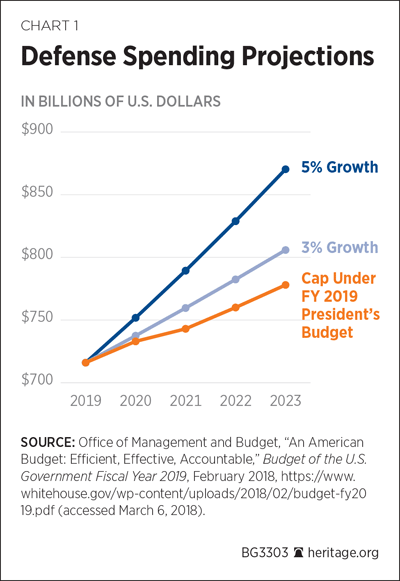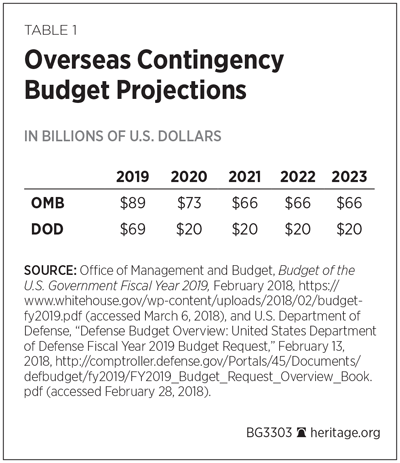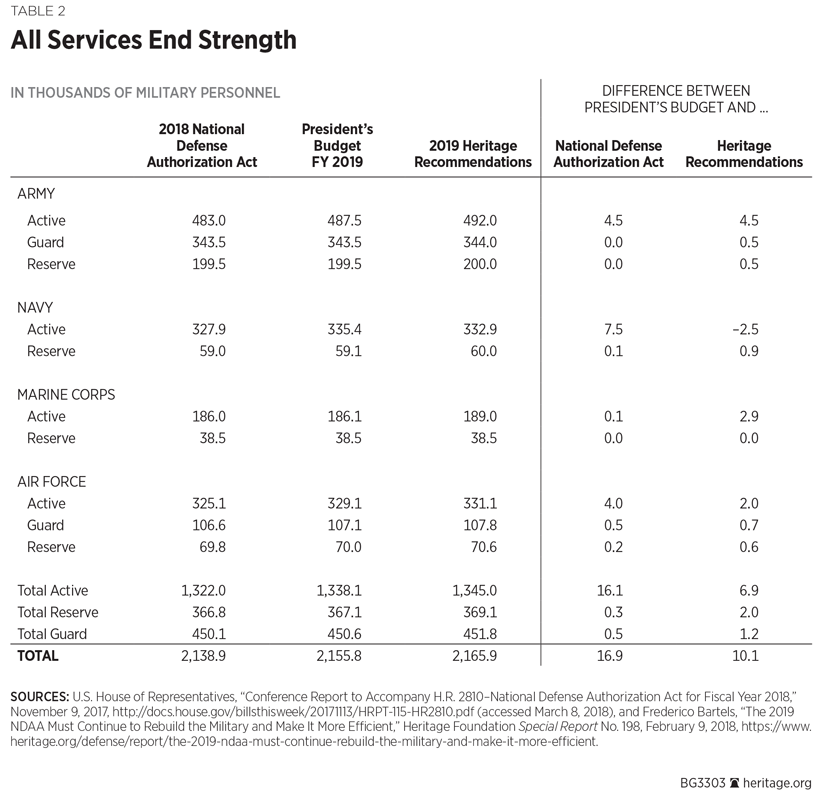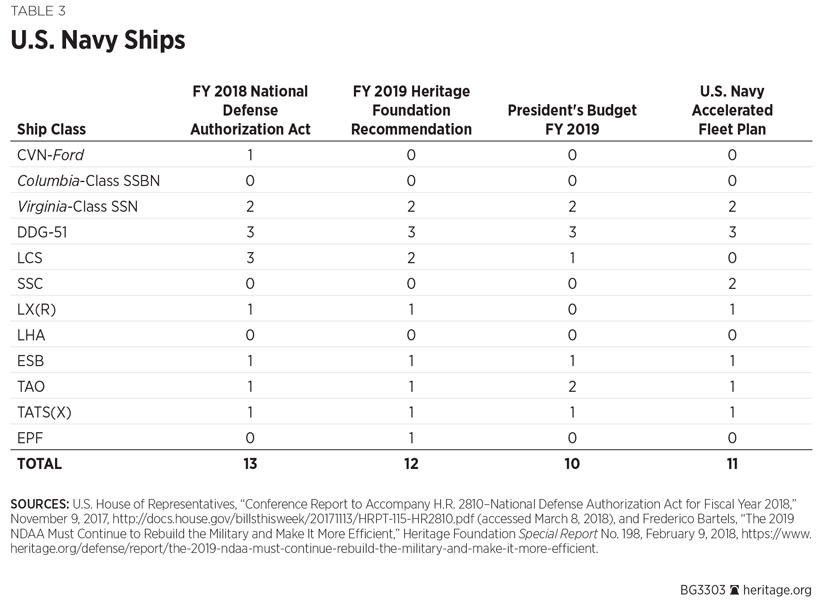The President’s budget request for fiscal year (FY) 2019 was prepared in a unique political moment, when there was still no final agreement on the appropriations level for FY 2018. It was submitted mere days after the deal on the budget levels for FYs 2018 and 2019 was reached.REF As such, the budget request for the Department of Defense (DOD) had some last-minute changes to make sure that the request reflected the topline agreement.
Nonetheless, the new budget request was submitted, and it needs to be properly scrutinized. After all, the urgently needed military rebuilding depends on it. It represents the next step in the crucial work to rebuild the Armed Forces.
In some ways, the DOD budget request for FY 2019 is similar to a swimming duck. On the surface, the topline looks calm due to the agreement between the executive and the legislative branches. But, there is plenty of movement below the surface. The DOD budget request raises many questions that Congress will need to address before a final 2019 appropriations bill is passed and signed by the President.
The goal of this Backgrounder is to raise these questions. It should serve as a guide for lawmakers and their staff as they navigate the budget request.
Topline and Future Projections
The Bipartisan Budget Act of 2018 raised the defense budget caps for 2018 and for 2019.REF The result is a much-needed increase that will enable the Department of Defense to start rebuilding the military. The way that the deal was reached will have substantial reverberations in the country’s economy. There are virtually no offsets, and thus the increase in spending will come through increased deficits, and thus increased debt.REF This is an unsustainable way to fund the federal government that will affect the nation’s defense and military over the long term.
Furthermore, the deal did not address the Budget Control Act (BCA) caps for either 2020 or 2021.REF It all but guarantees that the discussion on how to fund defense in 2020 will be replayed.
The defense budget plans from both the DOD and the Office of Management and Budget (OMB) feature 2 percent inflation adjustments in their plans from 2020 through 2023.REF These official projections further assume that the BCA caps will be modified again to allow the necessary level of spending.
Furthermore, these 2020–2023 projections do not appear to reflect the need expressed by Secretary of Defense James Mattis in his testimony on the needs of the DOD.REF The projected inflation-level growth is an enormous difference from the 3 percent to 5 percent annual increases until 2023 that Secretary Mattis testified were the absolute minimum for maintaining current military capabilities. Nonetheless, these concerns are not represented in the budget request. Rather than experiencing a robust continued growth, the defense budget after 2019 would flat-line to inflationary levels.

The projection of future defense budgets fails in two important counts. It ignores both the political reality of the BCA and the needs expressed by Pentagon senior leaders. The National Defense Strategy described the necessary budget to execute it as being “sustained,” “predictable,” and “increased.”REF The future years defense plan projections meet none of these criteria.
Overseas Contingency Operations
The Overseas Contingency Operations (OCO) account was created as an emergency account to enable the DOD to respond to the global war on terrorism.REF Since then, it morphed multiple times and has served to both fund base requirements and to work around the limitations imposed on defense spending by the BCA of 2011.REF The defense base budget ought to fully fund the enduring non-contingency requirements, and OCO should return to its proper role of funding actual emergencies.
In this President’s budget, OCO has become an even less-defined pot of money. Because the Bipartisan Budget Act of 2018 established new limits for the defense base budget, the DOD transferred some expenditures from OCO back to base, such as operations resources for all Services.REF In order to reflect these changes in the budget request, the DOD largely ignored the lines between OCO and base and created one single topline.REF Additionally, there are considerable discrepancies on the projected OCO numbers between the OMB’s and the DOD’s documentation.

Congress needs to properly question the DOD budget planners on the future of OCO. Nonetheless, it is important to have a clear understanding on the requirements for base and OCO functions. OCO should be phased out in time, while the base budget needs to fully fund defense requirements.
End Strength
Congress should assess the increased levels in end strength that the DOD has requested. The budget request calls for a larger force that grows from both the previous budget requests and from the National Defense Authorization Act for FY 2018.REF It is a positive move that is starting to modestly reverse the decline of the military from recent years. In all the recent defense budget discussions, there has been a consistent agreement on the need to increase the size of the active force.
The Services can and should accommodate a larger increase in their troop levels in 2019. The increase in the active force number is mostly dedicated to restoring the readiness gaps that each Service presents. For instance, the increased Army capacity is not dedicated to creating new brigade combat teams (BCTs), but rather filling out the gaps that exist in established BCTs.REF

Army. The President’s budget request for 2019 proposes to increase the size of the active Army by 4,500 soldiers to 487,500.REF The projections for 2023 reflect a proposed Army increase to 495,500.REF Army leaders have testified that the present Army is too small to handle its assigned missions or to execute the national military strategy.REF In this sense, the Army proposes to use this increase to fill holes in existing formations and to activate three additional Security Force Assistance Brigades.
Heritage Foundation analysts have proposed that the active force should be increased to 492,000 in 2019, an increase of 9,000 from the 2018 National Defense Authorization Act, and to reach a total of 520,000 by 2023.REF The Administration’s proposed increase, while necessary and welcome, is insufficient. Growth by 9,000 in 2019 is both feasible and necessary. A larger Army will provide the Pentagon with greater capacity to satisfy Combatant Commander requirements while at the same time allowing it to build increased readiness, striving to meet the Army Chief of Staff’s goal of 66 percent of BCTs in the “ready” category.
The budget request emphasizes training for the National Guard. This is an overdue and welcome development. The proposal provides the National Guard with four Combat Training Center rotations, which doubles previous commitments.REF
The budget also increases funding for Reserve Component soldiers on active duty supporting worldwide missions. This funding provides good return on investment by allowing Reserve Component soldiers to serve in a variety of roles supporting Combatant Commander missions and gain valuable experience.
Unsurprisingly, there are no new procurement programs in the 2019 request, since there are no Army programs ready to enter the procurement phase. This puts the Army at a disadvantage compared to the other Services that have new design systems coming off the production line, such as the Virginia-class submarine and the F-35 fighter. It also shows that there will be an increasing modernization gap between the Army and the rest of the Armed Forces.
The budget request does however reflect an increase in research, development, test, and evaluation, growing from $9.4 billion in 2018 to $10.2 billion in 2019.REF It suggests that the Army may be in a position to start buying new design systems in the future, with “Mobile Protected Firepower,” a system designed to provide more firepower for Infantry BCTs, and perhaps one of the first next-generation platforms to be fielded.
The Army continues to invest heavily in incremental upgrades for legacy systems, such as the Abrams tank, the Bradley Fighting vehicle, and the Paladin artillery platform. As Heritage research has recommended, the Army should pivot from this strategy of incremental upgrades to new design platforms as soon as possible.REF Future Vertical Lift and Next Generation Combat Vehicle development programs should be transitioned from their amorphous descriptive names into tangible programs to start delivering next-generation capability quickly.
Navy. The Navy budget request increases its manpower requirements to reflect force structure decisions, reduce manning gaps at sea, and improve fleet readiness. It funds an increase of 7,500 sailors in the budget, leading to a total of 335,400 personnel in 2019 and 344,800 personnel by 2023. This request is 2,500 sailors more than Heritage’s recommendation.REF
The increase will provide additional personnel to address the Comprehensive Review’s and Strategic Readiness Review’s ship manning and training recommendations, fully man the four Cruiser crews that are returning to operational status following completion of their Phase Modernization, and to address Special Operations Forces growth. All are welcome developments.
The budget request includes funding for the procurement of 10 new-construction battle force ships. While this is an increase over the Navy’s 2018 request of eight ships, it is still not sufficient to build the fleet toward the congressionally mandated requirement of 355 ships within the current 30-year shipbuilding plan. The pace is even more conservative than the Navy’s February 2017 “United States Navy Accelerated Fleet Plan.”REF The Accelerated Fleet Plan recommended the procurement of 11 battle force ships in 2019.
Additionally, the Accelerated Fleet Plan would have resulted in 10 additional ships, resulting in 64, instead of the budget’s 54, over the next five years. Heritage Foundation analysts recommended the procurement of 12 battle force ships in 2019 with the addition of one Expeditionary Fast Transport ship above the Accelerated Fleet Plan recommendations.REF It is highly likely that Congress will add at least one additional littoral combat ship (LCS) in 2019, and potentially two, to better maintain the LCS shipyard industrial base until the FFG(X) (next-generation-frigate) award in 2020.REF

In recent budget testimony, Senate and House committee members have pushed back on the Navy’s modest 2019 ship acquisition across the next five years as well as its new 30-year shipbuilding plan, stating that it was not aggressive enough in attaining the 355-ship requirement before the 2050s. Congress should indeed reject the modest plans of the Navy that fail to meet current requirements for the fleet size.
The budget’s aircraft procurement also falls short of the 18 F-35Cs and 23 F-35Bs recommended by both the Accelerated Fleet Plan and Heritage Foundation analysts.REF Instead, the budget calls for nine F-35Cs and 20 F-35Bs. Congress should correct this gap. Heritage experts also recommended procuring 4 EA-18G Growler Electronic Attack aircraft in 2019 to provide the fleet with additional aircraft to fulfill an increasingly critical mission.
The Strike Fighter Inventory Management strategy remains challenged with F/A-18A-D aircraft that will reach the end of their service lives before sufficient F-35 aircraft can be delivered into service. To help mitigate this near-term strike-fighter shortfall, the Navy plans to procure 24 F/A-18E/F aircraft in 2019. This request is consistent with the recommendations of both the Accelerated Fleet Plan and Heritage Foundation analysts.
The operation and maintenance budget supports a deployable battle force of 299 ships at the end of FY 2019, including 11 aircraft carriers and 33 large amphibious ships. It has funds for ship maintenance at “maximum executable levels” of 96 percent of the maintenance requirement in 2019 for a total of $9.8 billion, down from a total of $10.3 billion in 2018.REF The future focus ought to be on increasing the maximum executable level for the Service.
To start increasing capacity, the budget invests in Naval shipyards by expanding the workforce by approximately 3,187 personnel to increase shipyard output. Additionally, to better align workload to capacity, the budget funds private-sector submarine maintenance to reduce submarine maintenance and shipyard backlogs. Furthermore, to improve public shipyard capacity and efficiency, the Navy is providing $221 million to modernize the Norfolk ship maintenance facility and the Portsmouth Naval Shipyard’s Dry Dock No. 1.REF These are welcome developments that will allow the Navy to expand its future capabilities.
Marine Corps. Representing over 50 percent of its budget, manpower is a critical item for the Marine Corps.REF But unless the operational demand for Marine Corps forces is reduced, it will not be able to substantially relieve the operational tempo of its forces without expanding the Corps. Increasing the size of the Corps by another 10,000 to 15,000 Marines would enable the Service to meet operational demand, provide time for units back at home to engage in proper training and schooling, and create space for experimentation that is critical to preparing for the future.
In the budget request, the Marine Corps is looking to increase manpower to fill existing holes and to increase numbers for cyber operations, for example. But a growth of 1,100 over the next five years is paltry when considering what the Corps needs, likely in excess of 200,000 total.REF There are indications that the deployment-to-dwell ratio will remain at 1:2,REF thus it seems that the Corps will have a hard time creating personnel availability for training and maintenance.
Such a personnel increase would place increased demands on recruiting, training, education, equipping, and associated facilities and support, and would significantly increase the cost of the force since manpower is a long-term cost in itself.
But for the Corps to get “healthy” while sustaining all of the things it wants to do—conventional forces deployed 1:2, special operations, cyber operations, special purpose forces, and more—it simply has to get bigger. Alternatively, it needs to consider pulling back from some of its initiatives or seek desired capabilities, such as cyber capabilities, via support from other Services—similar to the medical support it gets from the Navy.
Marine Corps initiatives will also be frustrated by the level of funding the Navy is dedicating to its amphibious fleet, a consistent point of contention between the two Services. The Marine Corps would prefer to have 35 to 40 amphibious platforms of various types. The Navy has consistently given higher priorities to carriers, submarines, and surface combatants.
Like the Army, the Corps is not currently procuring any replacements for its armor, and its light armor vehicle is getting quite old. It is also in the same position with the Amphibious Combat Vehicle (ACV), with its funding request sustaining its approach to fielding the ACV 1.0 as an interim to replacing the old Assault Amphibious Vehicle.REF
The Corps has bet its aviation component on full fielding of the F-35B, since it did not echo the Navy in acquiring both the F-35 and F-18. Its acquisition profile reflects what industry can do with existing production lines. Thus, it is on track but fielding more slowly than is ideal.
The Corps has consistently stated that it is getting the funding it needs, and as much as it can realistically absorb at the moment. While true, the Corps needs to start thinking bigger and bolder than it has over the past several years.
Air Force. Funding for personnel will grow at just 11 percent, with 4,700 additional Airmen in 2019, 1,300 below Heritage analysts’ recommendation of 6,000 for that year.REF The stated goal of the Service is to average just 3,100 new positions a year over the course of the next five years.REF This is considerably below what is necessary to meet the needs of the Service’s missions.
In the Air Force budget, research, development, and engineering is getting the largest increase in funding, conveyed in a $10.8 billion increase in 2019. This demonstrates a focus on the force of the future, instead of the current one.REF
The B-21 is in the heart of its developmental stage and will receive a large portion of these resources, but the quest for all-encompassing situational awareness with Multi-Domain Command and Control will also enjoy a boost in funding. The Minuteman III and the nuclear-tipped Long Range Stand Off Munition are part of that mix as stated strategic priorities.
Space programs have suffered years of drought due to budget constraints. An increase in developmental funding for space superiority initiatives will ensure robust Global Positioning System (GPS), early warning, and intelligence, surveillance, and reconnaissance (ISR) capabilities, which are all essential. Each of these initiatives will pay dividends for the Air Force of the future, but they are years away from having any effect on the battlefield.REF
Procurement is set to increase by $3.3 billion, but not a penny of that will be used to increase the acquisition of, or rate of production for, the F-35A or KC-46. The funding increase will further the Air Force’s growing emphasis on simulators, allow for new engines for the B-52, and the purchase of munition stockpiles and war reserves.
The biggest concern is the Air Force’s funding for readiness. Of the $24 billion increase in overall funding for 2019, the Air Force will add just $3.0 billion in Operations and Maintenance. It is an increase slightly higher than inflation for each year of the two-year budget deal.REF
Senior leaders within the Air Force have stated the Air Force is already flying all the sorties it can execute due to reduced maintenance capacity driven by a limitation on supervisors in that field. That logic is sound on the surface, but a seeming lack of depth may reveal the Air Force’s real focus.
The Air Force is suffering the greatest readiness crisis this Service has ever known and fixing it will take time. Efforts to replenish its maintenance force have been successful and accessions have reduced the overall manpower shortfall to something negligible. While it will take a few years to regrow the required supervision to a healthy level, the number of maintenance supervisors grew at every level in 2017, as it will in 2018 and 2019.
But the increase in funding is not keeping pace with that growth. An increase for Operations and Maintenance funding of just 6 percent does not take advantage of the increased capacity.
Funding reveals priorities and, with the smallest percentage increase going to readiness, it appears that Air Force priorities may not be fully in line with those of the DOD, especially when it comes to emphasizing the current lethality of the force.
Base Realignment and Closures (BRAC)
For the first time in the past six years, the DOD did not request Congress to authorize a new round of Base Realignment and Closures (BRAC). The need has not gone away. The Infrastructure Capacity study indicating 19 percent in excess infrastructure is still the most current assessment of the Pentagon’s real estate usage.REF
Additionally, the National Defense Strategy clearly states that the “Department will also work to reduce excess property and infrastructure, providing Congress with options for a Base Realignment and Closure.”REF Delivering options to Congress on BRAC is a fairly modest promise, but the DOD failed to keep it.
A new round of BRAC is estimated to save over $2 billion annually in reduced fixed costs.REF This would cover most of the requested increase in the budget for additional military construction.REF
Congress should start empowering the DOD to conduct robust infrastructure assessments by loosening the current reporting requirements that exist whenever there is any proposed real estate change.REF These measures are short of authorizing a new round of BRAC but would represent a great step forward in the DOD’s current real estate management. Congress needs to then take the lead in changing how the Pentagon closes and realigns domestic military bases.
Reform Management Groups (RMGs)
When James Mattis took over as Secretary of Defense, one of the three lines of effort was to bring business reform to the Pentagon.REF This line of effort is currently being conducted under nine reform management groups that were established by Deputy Secretary of Defense Patrick Shanahan. According the budget request, “The RMG’s central goal is to leverage best practices, centers of excellence, and private sector sources to benchmark and best align business operations.”REF
The areas of reform are: information and technology, health care, real property, human resources, financial management, contracted services and goods, logistics and supply chain, community services, and testing and evaluation. Each of these areas represent a great opportunity for the DOD to improve and rationalize the way it conducts its business operations. Many of them are back-office functions that have the potential to save funding, but at the expense of the Services’ independence and individual interests.
That the DOD is taking a hard and fresh look at all these areas is welcome and Congress should seek to facilitate these efforts. Efficiencies are hard to garner and there are inevitably winners and losers. Congress should focus its attention on the overall impact of the proposed changes on the effectiveness of the DOD versus the individual losers.
Nonetheless, there is little detail on how these efforts are being conducted and what would be the goals in each of these areas. There is no clear definition for the public or Congress of what success would look like. This is the most substantial reform that is discussed in the President’s budget request, but it receives a very superficial treatment. Congress should request that the DOD better explain its goals with these RMGs.
Audit
There is a widespread belief in Congress that the DOD financial audit will identify large areas of waste or fraud, yet the audit experiences of other federal agencies and private corporations largely do not support that expectation. In the private sector, financial audits are primarily used to fulfill legal requirements and to increase investor confidence in financial statements, leading to a reduced cost to raise capital. There is no corresponding need for the DOD audit.
Audit results that lead to actual reduced waste or inefficiency are rare, and many companies that can legally escape undergoing financial audit choose to do so.REF There are better methods to reduce waste or inefficiency, such as “waste audits” or zero-based budgeting techniques.
Pentagon Comptroller David Norquist estimates that the 2018 audit of the DOD will require at least $870 million to complete.REF That is the equivalent of at least eight F-35A fighter aircraft, which U.S. forces desperately need. Costs may go down slightly in subsequent years, but Congress should nevertheless take the examination of the 2019 budget as an opportunity to push for ways to accomplish the most essential aspects of an audit at a lower cost in future years.
Recommended Actions for Congress
In light of these shortcomings in the President’s budget request, Congress should:
- Question the Administration’s plans for defense spending beyond 2019. The plans are just for inflationary growth in the coming years, instead of the robust growth assessed as necessary by Secretary Mattis. The plans for OCO were also ambiguous and they could determine the marginal increases or decreases of the defense topline.
- Assist the Pentagon in rebuilding the military. From increasing the end strength, to changing the shipbuilding plans and increasing the purchases of airplanes, Congress can and should help the military shape its rebuild.
- Take the initiative on real estate management. The budget request failed to request a new round of BRAC or even provide any options on the process. Congress should take the lead in the area and provide authority for the Pentagon to act on real property.
- Investigate the business reform. Business reform efforts through the RMGs have had little public discussion or debate. Nonetheless, if the Pentagon is going to get them done, it will likely require congressional support—and Congress should start making the case now.
Conclusion
There are multiple areas where the rhetoric of the Administration on rebuilding the military, as conveyed in the National Defense Strategy, does not seem to match the budgetary reality stated by the President’s budget request for 2019. These are issues that Congress needs to address when assessing the DOD budget request.
The budget settles for inflationary growth from 2020 to 2023, even when military leaders and the National Defense Strategy have expressed the need for sustained growth. The Army’s force structure does not grow fast enough to accommodate current demands. The Navy’s shipbuilding plans fall well short of their stated goal and sense of Congress, of a 355-ship fleet. The Marine Corps has not fundamentally changed its relationship between missions and available personnel. The Air Force does little to address the current readiness or shortages.
Furthermore, one of the three lines of effort for Secretary Mattis—reform—is reduced to an internal initiative on which Congress currently has little visibility.REF Despite the National Security Strategy recognizing the need for a new round of base closures, the DOD did not request one.
Congress and the executive branch already agree on a topline number for the defense budget in 2019. Nonetheless, the President’s budget request for the DOD falls short in a few important areas. Congress will have to lead in these areas if the United States is to have a proper and robust rebuilding of the military.
—Frederico Bartels is Policy Analyst for Defense Budgeting in the Center for National Defense, of the Kathryn and Shelby Cullom Davis Institute for National Security and Foreign Policy, at The Heritage Foundation. Thomas W. Spoehr is Director of, and Dakota L. Wood, John Venable, and Thomas Callender are Senior Research Fellows in, the Center for National Defense, of the Davis Institute.



